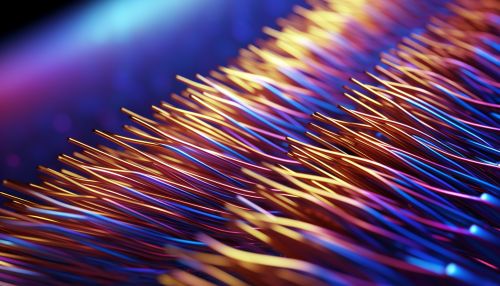Silicon Nanowires
Introduction
Silicon nanowires are a type of nanowire produced from a silicon-based substrate. Nanowires are extremely thin wires with a diameter on the nanometer scale, and silicon nanowires are a specific type of nanowire made from silicon. They are a promising material in the field of nanotechnology due to their unique properties and potential applications in areas such as electronics, photonics, and energy storage.


Synthesis
Silicon nanowires can be synthesized through several methods, including the vapor-liquid-solid (VLS) method, molecular beam epitaxy (MBE), and chemical vapor deposition (CVD). Each of these methods has its own advantages and disadvantages, and the choice of method can significantly influence the properties of the resulting silicon nanowires.
Vapor-Liquid-Solid Method
The Vapor-Liquid-Solid (VLS) method is a common method for synthesizing silicon nanowires. In this process, a tiny droplet of a metal catalyst, such as gold, is placed on a silicon substrate. The substrate is then heated and exposed to a silicon-containing gas. The metal catalyst droplet absorbs the silicon from the gas, forming a liquid alloy. Once the alloy becomes supersaturated with silicon, the excess silicon precipitates out of the alloy and forms a silicon nanowire.
Molecular Beam Epitaxy
Molecular Beam Epitaxy (MBE) is another method used to synthesize silicon nanowires. In this process, a beam of silicon atoms is directed at a substrate, where the atoms adhere and form a wire. The advantage of MBE is that it allows for precise control over the size and orientation of the nanowires.
Chemical Vapor Deposition
Chemical Vapor Deposition (CVD) is a versatile method for synthesizing silicon nanowires. In this process, a silicon-containing gas is introduced into a chamber containing a substrate. The gas reacts with the substrate to form a solid material, which grows into a nanowire. The advantage of CVD is that it can be used to grow nanowires directly on a substrate, which is useful for integrating the nanowires into devices.
Properties
Silicon nanowires have several unique properties that make them useful in a variety of applications. These properties include high surface-to-volume ratio, excellent electrical conductivity, and strong light absorption.
High Surface-to-Volume Ratio
Due to their small size, silicon nanowires have a high surface-to-volume ratio. This property is beneficial in applications such as sensors and batteries, where the performance of the device is often determined by the surface area of the material.
Electrical Conductivity
Silicon nanowires have excellent electrical conductivity, which makes them useful in electronic devices. The conductivity of silicon nanowires can be tuned by changing the diameter of the wire, the doping concentration, or the crystal structure of the silicon.
Light Absorption
Silicon nanowires have strong light absorption properties, which make them useful in applications such as solar cells and photodetectors. The light absorption of silicon nanowires can be enhanced by tuning the diameter and length of the wire, as well as the arrangement of the wires on the substrate.
Applications
Due to their unique properties, silicon nanowires have potential applications in a variety of fields, including electronics, photonics, energy storage, and sensing.
Electronics
In the field of electronics, silicon nanowires can be used to make transistors, diodes, and other electronic components. The small size and excellent electrical conductivity of silicon nanowires make them ideal for use in miniaturized electronic devices.
Photonics
In photonics, silicon nanowires can be used to make photodetectors, waveguides, and other optical components. The strong light absorption properties of silicon nanowires make them ideal for use in photonic devices.
Energy Storage
In the field of energy storage, silicon nanowires can be used to make high-performance batteries and supercapacitors. The high surface-to-volume ratio of silicon nanowires allows for a high capacity for storing energy.
Sensing
In the field of sensing, silicon nanowires can be used to make sensitive chemical and biological sensors. The high surface-to-volume ratio of silicon nanowires allows for a high sensitivity to changes in the environment.
